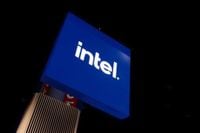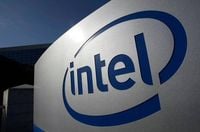Intel, once a towering figure in the world of chipmaking, has found itself at a dramatic crossroads in 2025. Recent quarterly results, released on October 24th and 25th, offer a story of cautious optimism, strategic pivots, and the unmistakable influence of outside forces—most notably, the United States government stepping in as a major shareholder. While the numbers on paper look encouraging, a closer look reveals a company still wrestling with legacy challenges, fierce competition, and a turnaround plan that’s far from complete.
According to Tom’s Hardware, Intel reported a net income of $4.1 billion, or 90 cents per share, for the third quarter of 2025. This marks a dramatic reversal from the $17 billion loss posted a year earlier. Revenue climbed 3% year-over-year to $13.7 billion, and the company’s gross margin improved to 38.2%. But as Tom’s Hardware and The New York Times both point out, much of this profit was driven by one-time gains—primarily the sale of a 51% stake in Intel’s Altera unit to Silver Lake and part of its Mobileye stake—rather than a fundamental turnaround in the company’s core business.
Operationally, Intel earned about $1 billion in the quarter, a figure that, while positive, is dwarfed by the $3 billion in asset-disposal gains that padded the bottom line. The company’s operating expenses were trimmed to $4.4 billion, down from $5.4 billion a year ago, with research and development spending falling to $3.231 billion. Restructuring charges, including layoffs and project cancellations under new CEO Lip-Bu Tan, also featured in the quarter’s results.
In the words of David Zinsner, Intel’s chief financial officer, “We took meaningful steps this quarter to strengthen our balance sheet, including accelerated funding from the U.S. Government and investments by Nvidia and SoftBank Group that increase our operational flexibility and demonstrate the critical role we play in the ecosystem.”
The Client Computing Group (CCG)—which covers chips for PCs and laptops—posted a robust quarter, raking in $8.5 billion in revenue, a 7.6% jump from the prior quarter and 5% increase year-over-year. According to Bernstein Research, CCG revenues were “particularly robust, >$400M above consensus driven by Windows 11 upgrade cycle and PC refresh and growing AI PC adoption.” Intel expects to exit 2025 with 100 million cumulative AI PCs sold, a target underscoring the company’s hopes to ride the AI wave.
But the good news is tempered by ongoing supply constraints. As Barclays noted, “the company pointed to supply constraints (likely to persist into 2026) and not being able to fully serve strong demand driven by AI workloads.” Much of the demand is for older-generation Intel 7 and Intel 10 nanometer chips, where the company is not increasing capacity and is struggling to transition customers to newer products. Bernstein Research cautioned that “demand exceeding supply” sounds encouraging, but the reality is “customers are less enthused by Intel’s newer products,” which could cost the company further market share.
The Data Center and AI Group (DCAI) also delivered, with revenue of $4.1 billion—up 5% quarter-over-quarter, though flat year-over-year. Operating income came in at $1 billion, with a margin of 23.4%, the best in several quarters. Growth was driven by AI infrastructure refreshes and expanding deployments of Xeon 6 ‘Granite Rapids’ processors, as noted by Tom’s Hardware. Intel shifted some capacity from client CPUs to data center processors to meet this demand, a move that improved product mix and average selling prices.
Despite these bright spots, Intel’s foundry business remains a sore point. Revenue from Intel Foundry was $4.24 billion, down 4% quarter-over-quarter and below analyst estimates. Citi analysts were blunt: “We believe investors think Intel’s merchant foundry business can be profitable, but we don’t given our belief that Intel’s foundry is years behind TSMC.” Bank of America echoed this skepticism, citing a slow internal adoption of the 18A node and tough competition in the U.S. Needham noted that Intel “appears to be increasingly challenged in the overall data center market, as it seems wallet share is shifting away from general-compute to AI-compute.”
Yet, the tone from Intel’s management is far more bullish than in previous quarters. HSBC highlighted that recent deals with the U.S. government, Nvidia, and SoftBank have “given Intel management a boost of confidence along with an improving balance sheet.” The U.S. government’s 10% stake, announced in August as part of the Chips and Science Act of 2022, brought in $8.9 billion. President Donald Trump, in a move that surprised many in his party, made the investment as part of a broader effort to shore up companies vital to national security. Intel, in turn, agreed to major investments in U.S. manufacturing facilities.
September brought a $5 billion investment from Nvidia, while SoftBank added $2 billion earlier in the year. The sale of the Altera stake and Mobileye shares further shored up Intel’s finances, giving CEO Lip-Bu Tan more time and capital to execute his turnaround strategy. According to JPMorgan, “Significant cash infusions in Q3/Q4 (Softbank, NVDA, US govt, Altera, MBLY) help to shore up the company’s balance sheet (de-levering remains a top capital allocation priority) while providing support for the company’s major capex initiatives amid fairly constrained [free cash flow] levels over the next several quarters.”
Wall Street has responded with guarded optimism. Intel shares surged nearly 8% in after-hours trading following the earnings release, briefly topping $41—their highest level since April 2024—before settling at $38.60, up 1.2%. As Investopedia reports, the stock has jumped 90% in 2025 so far, propelled by the government’s involvement and high-profile investments. Technical analysts see a bullish trend, with a potential near-term target of $49 per share. Key support levels to watch during any pullbacks are $36, $32, and $29.
Still, analysts remain wary about Intel’s long-term competitive positioning. As JPMorgan put it, “We still, however, view Intel’s competitive positioning as fundamentally challenged for the next 12-18 months.” The company continues to face stiff competition from TSMC in manufacturing and from Nvidia in AI chips—a sector where Intel has struggled to gain traction after missing earlier shifts, such as the move to mobile computing.
Looking ahead, Intel’s guidance for Q4 2025 is cautious, with expected revenue between $12.8 billion and $13.8 billion, reflecting seasonal factors and ongoing supply constraints. While the company’s management is optimistic about better non-AI server demand recovery and its AI chip strategy, the road to a full turnaround remains long and uncertain.
Intel’s latest results paint a picture of a company in transition—buoyed by outside capital, emboldened by new leadership, but still grappling with the realities of a hyper-competitive industry. The next year will test whether this infusion of cash and confidence can translate into lasting operational success.

